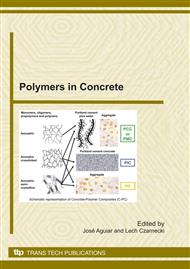p.1
p.15
p.21
p.29
p.37
p.47
p.57
p.65
Microstructural Analysis of Paste and Interfacial Transition Zone in Cement Mortars Modified with Water-Soluble Polymers
Abstract:
The presence of water-soluble polymers affects the microstructure of polymermodified cement mortar. Such effects are studied by means of SEM investigation. Polyvinyl alcohol-acetate (PVAA), Methylcellulose (MC) and Hydroxyethylcellulose (HEC) are applied in a 1 % polymer-cement ratio. The polymers provide an improved dispersion of the cement particles in the mixing water. The tendency of certain water-soluble polymers to retard the flocculation of the cement particles minimizes the formation of a water-rich layer around the aggregate surfaces. They also provide a more uniform distribution of unhydrated cement particles in the matrix, without significant depletion near aggregate surfaces. Both effects enable to reduce the interfacial transition zone (ITZ). The polymers also provide a more cohesive microstructure, with a reduced amount of microcracks.
Info:
Periodical:
Pages:
21-28
Citation:
Online since:
January 2011
Authors:
Price:
Сopyright:
© 2011 Trans Tech Publications Ltd. All Rights Reserved
Share:
Citation:


